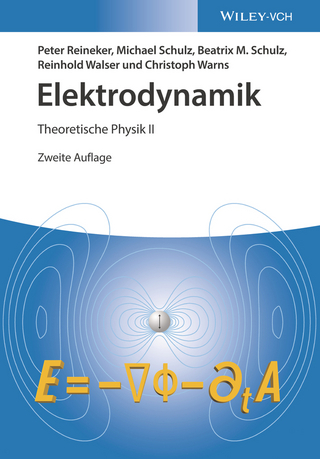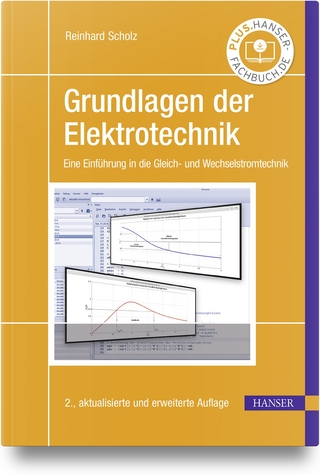
Applied Electromagnetics
Springer-Verlag New York Inc.
978-1-4684-0620-7 (ISBN)
1 Vector Analysis.- 1.1 Vector addition and subtraction.- 1.2 Multiplication with vectors.- 1.3 Vector differentiation.- 1.4 Fields.- 1.5 Gradient, divergence and curl.- 1.6 Double operations with del.- 1.7 Vector field classification.- 1.8 Coordinate systems.- 1.9 Data sheet.- Problems.- 2 The Electric Field.- 2.1 Coulomb’s law.- 2.2 Electric field strength E.- 2.3 Electric flux ? and electric flux density D.- 2.4 Gauss’s theorem.- 2.5 Maxwell’s first equation.- 2.6 Energy and potential.- 2.7 Conservative field.- 2.8 Potential gradient.- 2.9 The potential energy of a system of point charges.- 2.10 Energy density in an electric field.- Problems.- 3 The Electric Field and Materials.- 3.1 Current.- 3.2 The continuity equation.- 3.3 Metallic conductors.- 3.4 Boundary conditions in ideal conductors.- 3.5 Dielectrics.- 3.6 Capacitors and capacitance.- Problems.- 4 The Magnetic Field.- 4.1 Laws of magnetic force.- 4.2 Maxwell’s third equation: curl H.- 4.3 Maxwell’s curl equations.- 4.4 Stokes’ theorem.- 4.5 Maxwell’s fourth equation: div B.- 4.6 Maxwell’s equations for steady (d.c.) fields.- 4.7 Magnetic potential.- 4.8 Vector magnetic potential A.- 4.9 Inductance in terms of magnetic potential.- Problems.- 5 Magnetic Forces and Magnetic Media.- 5.1 Forces due to magnetic fields.- 5.2 Forces in circuits due to own fields.- 5.3 Magnetic media.- 5.4 Boundary conditions for magnetic media.- 5.5 Energy storage in the magnetic field.- 5.6 Mechanical force on magnetic material.- 5.7 Magnetic circuit.- Problems.- 6 Fields Varying in Time.- 6.1 Faraday’s law.- 6.2 Displacement current; Maxwell’s hypothesis.- 6.3 Maxwell’s equations, final forms.- 6.4 Boundary conditions.- 6.5 Field functions.- Problems.- 7 Electromagnetic Waves.- 7.1 Wave motion.- 7.2Free-space wave equations.- 7.3 Plane waves in homogeneous loss-free media.- 7.4 Poynting’s vector 𝓟.- 7.5 Plane waves in a medium having loss.- 7.6 Radiation pressure.- Problems.- 8 Field Problems-Non-exact Solutions.- 8.1 Two-dimensional fields: basic principles.- 8.2 Current flow in a thin conducting-sheet.- 8.3 Free-hand mapping.- 8.4 Field correlation with analogues.- 8.5 Numerical methods.- Problems.- 9 Field Problems-Analytical Solutions.- 9.1 Kelvin’s method of images.- 9.2 Conformal transformation.- 9.3 Separation of variables.- Problems.- 10 Some Low-frequency Applications.- 10.1 General observations about Maxwell’s equations.- 10.2 Maxwell’s equations applied to a transformer.- 10.3 Diffusion equation.- 10.4 Field produced by an element of changing flux.- 10.5 The electromagnetic pump.- 10.6 Drift and diffusion in semiconductors.- 10.7 The abrupt p-n junction.- Problems.- 11 High-frequency Effects.- 11.1 Phase and group velocity.- 11.2 The refractive index.- 11.3 Transmission and reflection of waves.- 11.4 Fibre Optics.- 11.5 Electromagnetic waves on a transmission line.- 11.6 Transverse electric waves.- Problems.- Appendix 1: The Three Main Coordinate Systems.- A1.1 Component transform matrices.- A1.2 Variable transforms.- A1.2.1 Change components and datum vectors.- A 1.2.2 Change variables x, y, z to ?, ?, z.- Appendix 2: Useful Data.- A2.1 Fundamental physical constants.- A2.2 Vector identities.- A2.3 Vector operations.- A2.3.1 Divergence.- A2.3.2 Gradient.- A2.3.3 Curl.- A2.3.4 Laplacian.- Appendix 3: Solid Angle.- A3.1 Examples of solid angles.- Appendix 4: Gaussian Elimination Program.- Solutions to Selected Problems.- References.
| Zusatzinfo | XVI, 288 p. |
|---|---|
| Verlagsort | New York, NY |
| Sprache | englisch |
| Maße | 155 x 235 mm |
| Themenwelt | Naturwissenschaften ► Physik / Astronomie ► Elektrodynamik |
| Naturwissenschaften ► Physik / Astronomie ► Optik | |
| ISBN-10 | 1-4684-0620-5 / 1468406205 |
| ISBN-13 | 978-1-4684-0620-7 / 9781468406207 |
| Zustand | Neuware |
| Informationen gemäß Produktsicherheitsverordnung (GPSR) | |
| Haben Sie eine Frage zum Produkt? |
aus dem Bereich


